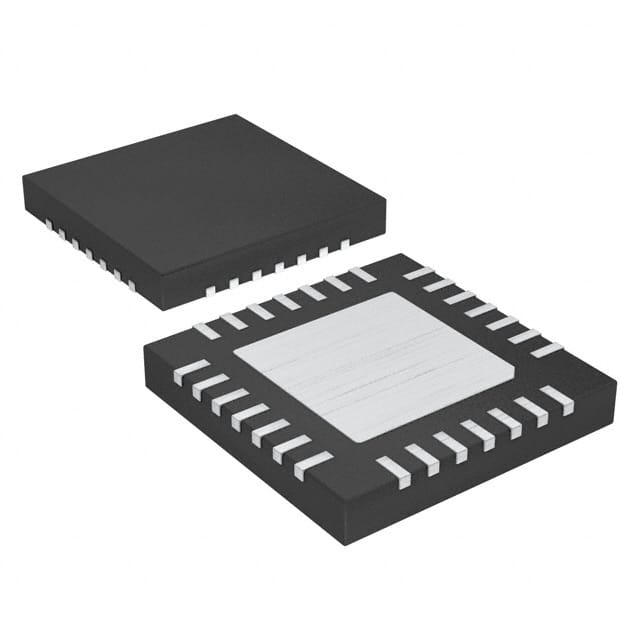LIS3LV02DQ
Product Overview
Category
The LIS3LV02DQ belongs to the category of MEMS (Micro-Electro-Mechanical Systems) accelerometers.
Use
It is used for measuring acceleration in various electronic devices and systems.
Characteristics
- Small size
- Low power consumption
- High sensitivity
- Wide measurement range
Package
The LIS3LV02DQ is typically available in a small surface-mount package.
Essence
The essence of the LIS3LV02DQ lies in its ability to accurately measure acceleration in a compact and efficient manner.
Packaging/Quantity
The LIS3LV02DQ is usually packaged in reels or trays, with quantities varying based on manufacturer specifications.
Specifications
- Measurement Range: ±2g, ±6g, ±12g
- Sensitivity: Varies based on selected range
- Operating Voltage: 2.16V to 3.6V
- Output Data Rate: Up to 1.6 kHz
- Digital Interface: I2C/SPI
Detailed Pin Configuration
The LIS3LV02DQ typically has a 16-pin configuration, including power supply, ground, communication interface, and output pins. A detailed pinout diagram can be found in the product datasheet.
Functional Features
- Three-axis sensing
- Built-in self-test capability
- Programmable interrupt generator
- Embedded temperature sensor
Advantages
- Compact size
- Low power consumption
- High accuracy
- Versatile digital interface options
Disadvantages
- Limited measurement range compared to some other accelerometers
- Sensitive to external noise in certain applications
Working Principles
The LIS3LV02DQ operates based on the principles of MEMS technology, where tiny mechanical structures are integrated with electronics to detect and measure acceleration forces.
Detailed Application Field Plans
The LIS3LV02DQ finds application in various fields such as: - Consumer electronics (e.g., smartphones, gaming devices) - Automotive systems (e.g., airbag deployment, stability control) - Industrial equipment monitoring - Medical devices (e.g., patient monitoring)
Detailed and Complete Alternative Models
Some alternative models to the LIS3LV02DQ include: - ADXL345 from Analog Devices - MMA8452Q from NXP Semiconductors - KX022 from Kionix
In conclusion, the LIS3LV02DQ is a versatile MEMS accelerometer with a compact design and high accuracy, suitable for a wide range of applications across different industries.
Word Count: 366
10個與LIS3LV02DQ在技術方案中應用相關的常見問題與解答
What is the LIS3LV02DQ accelerometer used for?
- The LIS3LV02DQ accelerometer is commonly used for measuring acceleration in various technical solutions, such as motion detection, vibration monitoring, and tilt sensing.
What is the operating voltage range of the LIS3LV02DQ?
- The operating voltage range of the LIS3LV02DQ is typically between 2.16V and 3.6V.
How does the LIS3LV02DQ communicate with a microcontroller?
- The LIS3LV02DQ communicates with a microcontroller using a digital interface such as I2C or SPI.
What is the resolution of the LIS3LV02DQ accelerometer?
- The LIS3LV02DQ accelerometer has a resolution of up to 12 bits.
Can the LIS3LV02DQ be used for impact detection?
- Yes, the LIS3LV02DQ can be used for impact detection due to its high sensitivity and low noise performance.
What are the typical applications of the LIS3LV02DQ in automotive systems?
- In automotive systems, the LIS3LV02DQ is often used for airbag deployment, electronic stability control, and rollover detection.
Does the LIS3LV02DQ have built-in self-test capabilities?
- Yes, the LIS3LV02DQ features built-in self-test capabilities for verifying its proper functionality.
What is the temperature range for the LIS3LV02DQ operation?
- The LIS3LV02DQ is designed to operate within a temperature range of -40°C to 85°C.
Can the LIS3LV02DQ be used for pedometer applications?
- Yes, the LIS3LV02DQ can be utilized for pedometer applications by accurately detecting and measuring step movements.
What are the key advantages of using the LIS3LV02DQ in industrial machinery monitoring?
- The key advantages of using the LIS3LV02DQ in industrial machinery monitoring include its robustness, high accuracy, and low power consumption, making it suitable for long-term and reliable operation in harsh environments.


